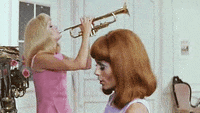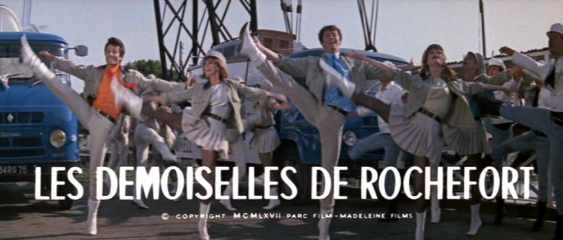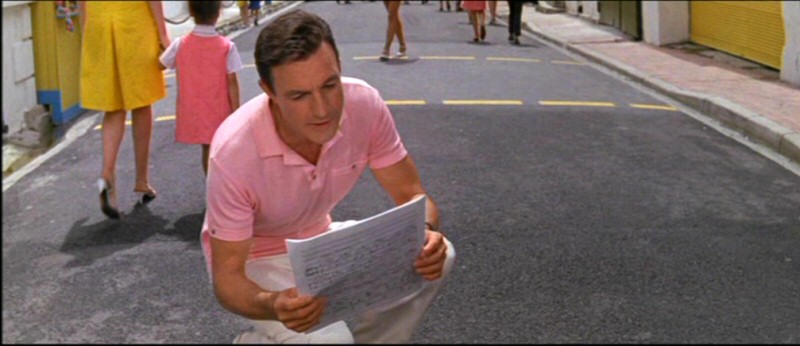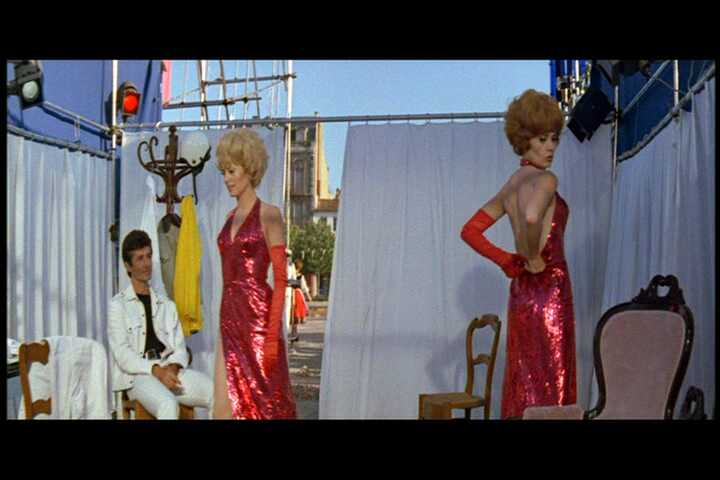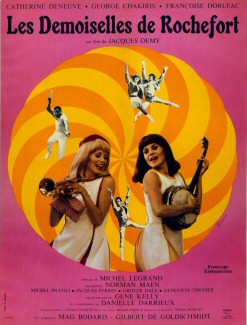- From the Chicago Reader (November 27, 1998), and reprinted in my collection Essential Cinema and on the BFI Blu-ray of the film. In his audiovisual essay on the latter release, Geoff Andrew rightly corrects my error, below, of describing the ax murder victim as Demy’s Lola, not von Sternberg’s Lola Lola. — J.R.
The Young Girls of Rochefort
Rating **** Masterpiece
Directed and written by Jacques Demy
With Catherine Deneuve, Françoise Dorléac, George Chakiris, Gene Kelly, Danielle Darrieux, Michel Piccoli, Grover Dale, Jacques Perrin, Geneviève Thénier, Henri Crémieux, and Jacques Riberolles.
As eccentric as this may sound, Jacques Demy’s 1967 Les demoiselles de Rochefort is my favorite musical. Yet despite my 30-year addiction to the two-record sound track, the first time I was able to see the movie subtitled was a couple of weeks ago — helpful considering my faltering French. It’s certainly the odd musical out in terms of both its singularity and its North American reputation — a large-scale tribute to Hollywood musicals shot exclusively in Rochefort in southwest France, and an unabashedly romantic paean to American energy and optimism that’s quintessentially French. It has a score by Michel Legrand that’s easily his best, offering an almost continuous succession of songs with lyrics by Demy, all written in alexandrines (as is a climactic dinner scene that’s spoken rather than sung); choreography that ranges from mediocre (Norman Maen’s frenchified imitations of Jerome Robbins) to sublime (Gene Kelly’s choreography of his own numbers); and perhaps the most beautiful dovetailing of failed and achieved connections apart from Shakespeare and Jacques Tati’s Playtime, shot during the same period.
When it comes to charting movie genres and traditions, most of this film’s virtues fall off the map. Joseph McBride invited me to contribute to his recently published Book of Movie Lists, and I opted for a list of the ten best jazz films — neither the best films about jazz nor the best examples of filmed jazz but something more rarefied: movies in which the aesthetics of jazz and the aesthetics of film find some happy, mutually supportive meeting ground. The Young Girls of Rochefort certainly qualifies: from Legrand’s improvised piano solos and big-band arrangements to stretches of scat singing and Demy’s allusions to Louis Armstrong, Count Basie, Duke Ellington, and Lionel Hampton, this movie swings. Even when the choreography is less than it might have been, Demy’s sweeping cranes and extended pans and intricate mise en scène cook as infectiously as a first-rate rhythm section.
It’s also a musical that periodically defamiliarizes — “makes strange” — the form of the musical. Defying the obsessive symmetry and frontality of Hollywood numbers, dancing extras here move at the periphery of the frame in certain shots. There are two cheerful songs about an ax murder, “The Woman Cut Into Pieces” and another just afterward about policing the crowd near the scene of the crime. And Demy’s clear tributes to Hollywood musicals — On the Town, An American in Paris, Gentlemen Prefer Blondes — wind up making the movie seem more French than American.

Most musicals shift back and forth between story (spoken dialogue) and song-and-dance numbers — sometimes creating queasy transitions just before or after these shifts, when we’re uncertain where we are stylistically. But The Young Girls of Rochefort often daringly places story and musical numbers on the screen simultaneously, mixing them in various ways and in different proportions. One of the stars may be walking down the street, for example, but the pedestrians around her are suddenly dancing, and she slips momentarily in and out of their choreography. This curious mix produces powerful, deeply felt emotions — an exuberance combined with a sublime sense of absurdity, shot through with an almost constant sense of loss, yearning, and even tragedy. Yet the coexistence of this strangeness and this intensity will inevitably make some American viewers laugh in disbelief and regard the whole spectacle as an esoteric piece of camp. (The same problem exists to a lesser extent in two of my favorite American freak musicals, Love Me Tonight and Hallelujah, I’m a Bum, both of which display a related metaphysical impulse to perceive the musical form as a continuous state of delirious being rather than a traditional story with musical eruptions.)
Some American viewers may find it difficult to feel their way into such an aesthetic overload. In France the film was revived regularly even before its 1996 restoration by Demy’s widow, Agnès Varda (who has a walk-on as a nun). And in her wonderful documentary about the film — The Young Girls Turn 25, which I saw at the Chicago International Film Festival in 1993 — we encounter a French teenager with a backpack who proudly and calmly informs us that she carries the CD of Bach’s Saint Matthew Passion and the video of Les demoiselles de Rochefort everywhere she goes, unwilling to spend even a night without them. Such a degree of passion about art is bound to seem demented in a “utilitarian” (i.e., money-minded) society such as ours, but it’s entirely compatible with the degree of passion expressed in the film itself. And surely the reluctance of some American filmgoers to go with that kind of flow partly accounts for Miramax’s refusal to allot any advertising budget to the movie’s Chicago engagement.
Received opinion on musicals is that the genre’s greatest achievements — such as the entertaining Astaire-Rogers steamrollers and Singin’ in the Rain — are triumphs of engineering, coordination, and expertise; it’s almost as if we judge this art the way we judge our smart bombs and sporting events. This quantitative aesthetic doesn’t allow for the possibility that a musician with limited technique like Thelonious Monk might be a greater pianist than a virtuoso like Oscar Peterson. And unless you conclude that the only reason for “technique” is to express what you want to say, the technical shortcomings of The Young Girls of Rochefort are bound to be disappointing. The verdict of critic Gary Carey in the late 70s is characteristic: “Unfortunately Demy, who had been so good at choreographing the movements of ordinary people through his camera, does not know how to photograph the choreography of dancers. (He doesn’t have much of an eye as to what is good choreography and what isn’t, either.) The film falls to pieces whenever anyone begins to dance, and since someone is always dancing, it ends as a pile of very pretty rubble.” Pauline Kael wrote in separate articles that “a movie like The Young Girls of Rochefort demonstrates how even a gifted Frenchman who adores American musicals misunderstands their conventions” and “it was obvious from Rochefort that [Demy] had — momentarily, I hope — run dry.”
Made on the heels of Demy’s The Umbrellas of Cherbourg, which enjoyed worldwide success, this extravaganza — which had a much bigger budget than Cherbourg — might well be considered an attempt to do the impossible if one views it as an imitation of the Hollywood musical rather than an inspired appropriation of some of its elements. It would, of course, be unreasonable to expect a facsimile of the Hollywood musical from a filmmaker with no stage or film-musical experience (apart from The Umbrellas of Cherbourg) and without the resources of a Hollywood studio or an indigenous tradition. But there’s no reason to believe that Demy — a filmmaker with a fully developed style and vision of his own when he made Les demoiselles de Rochefort — intended to reproduce something we already have. An English-language version shot simultaneously — which I’ve never seen, and which has been so scarce since the 60s it may no longer exist — was a commercial prerequisite for the film getting made, but it was the subtitled version that opened in New York in April 1968. It was so poorly received commercially that Demy’s career never fully recovered, and we’ve had to wait 30 years to see the movie again.
The film unfolds over a single weekend. On Friday morning a team of boat, bicycle, and motorcycle salespeople in trucks and on motorcycles and horses, including Etienne (George Chakiris) and Bill (Grover Dale), arrive in Rochefort by ferry. As they set up their stands and stages in the huge city square for the fair on Sunday afternoon, the camera pans, cranes up, then pans again to the studio where Delphine (Catherine Deneuve) and her twin sister Solange (Françoise Dorléac) are giving a combined music and dance class to kids. We discover that Delphine is a ballet teacher and dancer, Solange a composer and singer, and that both dream of meeting their romantic ideals and moving to Paris. (Deneuve and the late Dorléac — who died in a car accident the same year Les demoiselles was released — were real-life sisters but not twins: Dorléac was one year older than Deneuve. This is their only movie together, though both appeared separately in films by François Truffaut and Roman Polanski.)
It turns out that Delphine’s ideal man, whom she’s never met, is an artist and sailor currently stationed in Rochefort, Maxence (Jacques Perrin): the ideal woman he’s painted, whom he’s been searching for across the globe, is a dead ringer for Delphine. His canvas hangs in a local gallery run by Delphine’s unsuccessful suitor, Guillaume (Jacques Riberolles). The sisters have a ten-year-old half brother named Boubou; their mother, Yvonne (Danielle Darrieux), runs the cafe-restaurant in the city square, which Maxence, Etienne, and Bill all frequent. Unbeknownst to the family, Boubou’s father has recently moved back to Rochefort to run a music store; Yvonne had backed out of marrying Simon Dame (Michel Piccoli) years earlier, when she became pregnant with Boubou, because she couldn’t face the prospect of being called Madame Dame. Though Simon knew she’d had twins by a former lover, he’d never seen them, so when Solange comes to his shop and they become acquainted, he has no idea that she’s one of Yvonne’s daughters.
It’s love at first sight when Solange encounters an old friend of Simon Dame — famous American composer and concert pianist Andy Miller (Gene Kelly) — while she’s collecting Boubou from school. She has no idea this man is Miller, whom she wanted to meet so he could hear her piano concerto. They don’t exchange names or addresses, but he has a page from her score, which she inadvertently leaves behind. Meanwhile, when two of the young women in the show planned for the Sunday fair run off with a couple of sailors, Etienne and Bill convince Delphine and Solange to stage a number in their stead, promising them a free ride to Paris afterward….
Apart from the ax murder and periodic dark reminders of the nearby soldiers in training, both of which further develop the theme of thwarted desire, these are the basic elements of the plot, and Yvonne’s cafe on the square is the hub of all the complex comings and goings. (Like many of the buildings in Playtime, this freestanding structure has huge glass windows, allowing us to see much of the surrounding traffic.) But to summarize these intricate moves, characters who are ideally suited keep missing each other as they go about their daily routines; in most cases they don’t even realize that they’re occupying the same city. And even though The Young Girls of Rochefort is on all counts Demy’s most optimistic film — the one in which every character eventually finds the person she or he is looking for — the missed connections preceding this resolution are relentless, and one may still wind up with a feeling of hopeless despair despite the overdetermined happy ending. Indeed, the split second by which Maxence misses Delphine at the cafe before he’s shipped away might well be the most tragic single moment in all Demy’s work, perhaps even surpassing the grisly suicide at the end of Un chambre en ville. By contrast, when the “ideal couple” do eventually meet (an event represented only obliquely) in the film’s final shot, it’s a simple concession to musical- comedy convention, registering only as a sort of offhand diminuendo and postscript; what reverberates more decisively is the sense of dreams just missing realization.
In fact the movie overall leaves one in a unique manic-depressive state, a kind of poetic fugue in which boundless despair and exuberant optimism coexist. This is Demy’s vision of life — Lola and The Umbrellas of Cherbourg are suffused with much the same ambiguous mixture — but thanks to Legrand’s buoyant score and the size of the canvas, The Young Girls of Rochefort conveys it with unparalleled vibrancy and luminosity.
If songs and dances represent fantasy, and everyday activities reality, it can’t be said that Demy ever privileges one over the other; he’s more concerned with how fantasy and reality interact, or fail to interact. One might say that the missed connections in the film represent reality — the characters are too engrossed by everyday life to see that their ultimate dreams are only a block or so away — and that the eventual successful connections represent fantasy, the dreamlike closure of musical comedy. But in fact Demy is a much subtler dialectician, converting the Cartesian principle of French life and culture — “I think, therefore I am” — into “I dream, and dreaming is a part of life, therefore I live.” Furthermore, by staging all his musical numbers in real locations rather than on sets, Demy deliberately mixes his modes, with the result that the missed connections are as much a function of his mise en scène as the chance encounters. A poetic realist as well as a dreamer, Demy confused some audiences and critics throughout his career, much as his mentor Tati did, by keeping a firmer grip on the realities he was filming than many were prepared to see at the time. For viewers trained to regard fantasy as an alternative to reality rather than part of the reality of consciousness, Demy’s mixture is bound to seem jarring — though it may also jar one into perceiving a richer reality than most entertainments acknowledge.
The film’s chance encounters and missed connections are expressed not only spatially but musically, in the score and in Demy’s delicately crafted lyrics. Maxence’s song about his search is reprised as Delphine’s song about her own longings; Simon’s account of his lost love becomes, with appropriate alterations in the lyrics, Yvonne’s own regrets about having abandoned him; Solange’s piano concerto takes on lyrics after Andy intercepts the score. Many other reprises are less obvious than these. The song that goes with policing the crowd, for instance, reprises and adds lyrics to a secondary theme from the opening dance number in the city square. Both sequences emphasize community over individual destiny: here, as elsewhere in the film, Legrand and Demy enrich the meaning of other scenes by playing with the emotional and thematic effects of rhyme.
Masterpieces normally connote perfection, but it might be argued that some of the imperfections in The Young Girls of Rochefort enhance the overall experience by bringing it closer to life, making the actors seem more vulnerable. (Other imperfections, like the product plugs during the climactic fair — another parallel with Playtime, given some of its neon signs — are simple reminders of the difficulties of making big-budget French movies.) Darrieux, for instance, is the only cast member who does her own singing, though the dubbing of the others is usually carried out well, with the actors’ singing voices carefully matched to their speaking voices (including Kelly’s spoken French). More artificial are Delphine’s and Solange’s performances on trumpet and flute.
Yet given some of Demy’s original plans for the movie, it’s a miracle it turned out as well as it did. Before he selected Rochefort as his location, he considered making “Les demoiselles d’Avignon,” “Les demoiselles d’Hyeres,” “Les demoiselles de Toulouse,” and “Les demoiselles de La Rochelle,” among others. Rochefort won out because of the size of its central square, though production designer Bernard Evein found it necessary to repaint 40,000 square meters of the city’s facades. (Still, director André Téchiné has cited the movie as one of the best ever made about this part of France.) Even more improbable, Demy originally thought of casting Brigitte Bardot and Geraldine Chaplin as the twin sisters.
Demy also planned to make more extensive references to The Umbrellas of Cherbourg by casting Nino Castelnuovo, the hero of that film, as Bill. When Castelnuovo proved unavailable, Demy had to change the script. But it’s worth pointing out that the offscreen victim of the ax murder is Lola, the title heroine of Demy’s first feature, and there are many other allusions to earlier Demy films throughout: According to critic Jean-Pierre Berthomé, the three successive endings of The Young Girls of Rochefort replicate the final shots of Bay of Angels, The Umbrellas of Cherbourg, and Lola. And both Lola and The Young Girls of Rochefort associate Americans with white convertibles.
Given the extraordinary lift Gene Kelly gives the movie, it’s hardly surprising that Demy wanted him from the outset, though he had to wait two years before Kelly was free of other commitments. Indeed, Kelly brings to the movie the kind of boundless elation musicals exist to produce, as do Chakiris and Dale, the other two American dancers featured, though to a lesser extent. Indeed, it’s the combination of this spirit with the soul of the French cast that gives The Young Girls of Rochefort its distinctive flavor. Like the pairing of Jean Seberg with Jean-Paul Belmondo in Godard’s Breathless, or the mating of a David Goodis plot with Charles Aznavour’s mug in Truffaut’s Shoot the Piano Player, this combination provides the kind of combustion that powered the French New Wave and the general reinvention of movie energy in the 1960s. Godard and Truffaut may have watered the roots, but it was Demy who produced this relatively late blooming flower, combining the virtues of the Hollywood musical with French poetic realism to produce these fresh, colorful petals.
